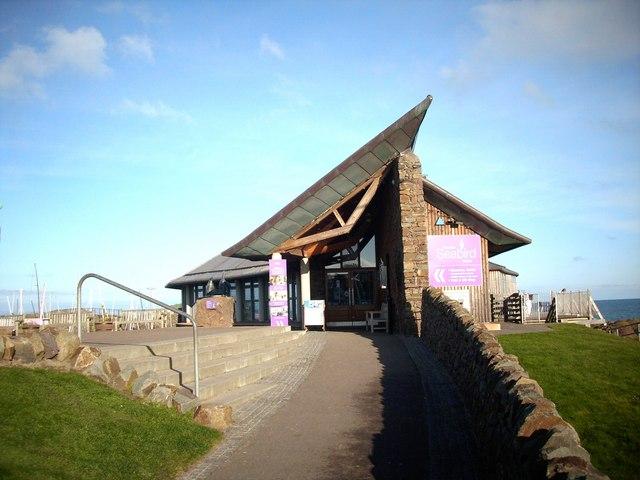'Scottish Seabird Centre', Hamish Macandrew
Wed, Aug 31st 2016 at 7:00 pm - 8:30 pm
Image Geograph.co.uk James Denham

THE SCOTTISH SEABIRD CENTRE, NORTH BERWICK
Our speaker today was Hamish Macandrew, who is a trustee of the Scottish Seabird Centre, which is a charity. The aim of the charity is to raise awareness about wild life and the benefits to the local community.
He outlined the history of the site, Anchor Green, in North Berwick. It was a stopping off place for pilgrims going to St Andrews and was associated with the witch trials in the time of King James VI. For many years it was the site of a saltwater swimming pool and was a very busy place full of holidaymakers. However the advent of package holidays to the Mediterranean meant that people holidayed less at home and the swimming pool was closed in the 1980’s. There were 10 years of fundraising in North Berwick prior to the completion of the Seabird Centre.
Hamish described how all the islands in the Forth including the Bass Rock and the Isle of May had solar powered cameras that with microwave technology could be operated from the seabird centre allowing close observation of birds and grey seals. Grey seals are common on the isle of May, but are rare in the rest of the world. The centre has a “discovery” centre within it and here the visitor can find out about the various islands in the Firth of Forth and there is a “bird identification” zone.
The centre also has a tidal tank, a theatre, children’s play area, shop and café. There are boat trips. The fast boat was not for the faint-hearted. The slow boat was less likely to cause seasickness and operated a 40 minute ferry service to Anstruther.
Hamish concentrated on two species of birds namely gannets and puffins.
Gannets nest on the Bass Rock, which is the remains of a volcano, 320 million years old. The Bass Rock has been a religious retreat and a prison and had a chapel and walled garden and a hermit. The colour of the rock changes from grey in the winter to white in the summer and this is solely due to the white colour of the gannets and not their faeces. Gannets are Britain’s largest seabird. They have brilliant eyesight and can follow shoals of fish. They hit the water at 60 mph and can fly underwater. They mate for life, return to the same nest each year and can live for 30 years. Young gannets are called gulags. Hamish described how the centre is building “runways” to help the gulags fly as the only way they know how to take off is to leap off a ledge.
Puffins nest mainly on the Isle of May and spend much less time there than gannets do on the Bass rock. They nest in rabbit burrows and have a symbiotic relationship with rabbits. Puffins too can fly underwater and catch sand eels. The numbers of sand eels indicate the quality of the water which has improved over the years. The numbers of puffins had been declining due to the growth of tree mallows, but with the cutting down of these by volunteers, the numbers are rising again. Hamish described how young puffins (pufflings) get lost by mistaking the lights of North Berwick for the moon and are often found under cars in the town. The locals now know to check the underside of their vehicles in the morning. Any pufflings are put back in the Forth and survive.
Apart from seabirds other wildlife that can be seen from the boats are bottle-nosed dolphins, occasional whales and even turtles.
Hamish finished by describing the plans to extend the centre. The aim is for the completed building, which will be called The National Maritime Centre, to give information about all aspects of the sea and not just the wildlife. It is hoped that it will be 50 to 60% funded from the Lottery Heritage Fund.
Ken Lindsay gave the club’s vote of thanks to Hamish for a most interesting, stimulating and informative presentation.
Report by Peter McGavigan
Our speaker today was Hamish Macandrew, who is a trustee of the Scottish Seabird Centre, which is a charity. The aim of the charity is to raise awareness about wild life and the benefits to the local community.
He outlined the history of the site, Anchor Green, in North Berwick. It was a stopping off place for pilgrims going to St Andrews and was associated with the witch trials in the time of King James VI. For many years it was the site of a saltwater swimming pool and was a very busy place full of holidaymakers. However the advent of package holidays to the Mediterranean meant that people holidayed less at home and the swimming pool was closed in the 1980’s. There were 10 years of fundraising in North Berwick prior to the completion of the Seabird Centre.
Hamish described how all the islands in the Forth including the Bass Rock and the Isle of May had solar powered cameras that with microwave technology could be operated from the seabird centre allowing close observation of birds and grey seals. Grey seals are common on the isle of May, but are rare in the rest of the world. The centre has a “discovery” centre within it and here the visitor can find out about the various islands in the Firth of Forth and there is a “bird identification” zone.
The centre also has a tidal tank, a theatre, children’s play area, shop and café. There are boat trips. The fast boat was not for the faint-hearted. The slow boat was less likely to cause seasickness and operated a 40 minute ferry service to Anstruther.
Hamish concentrated on two species of birds namely gannets and puffins.
Gannets nest on the Bass Rock, which is the remains of a volcano, 320 million years old. The Bass Rock has been a religious retreat and a prison and had a chapel and walled garden and a hermit. The colour of the rock changes from grey in the winter to white in the summer and this is solely due to the white colour of the gannets and not their faeces. Gannets are Britain’s largest seabird. They have brilliant eyesight and can follow shoals of fish. They hit the water at 60 mph and can fly underwater. They mate for life, return to the same nest each year and can live for 30 years. Young gannets are called gulags. Hamish described how the centre is building “runways” to help the gulags fly as the only way they know how to take off is to leap off a ledge.
Puffins nest mainly on the Isle of May and spend much less time there than gannets do on the Bass rock. They nest in rabbit burrows and have a symbiotic relationship with rabbits. Puffins too can fly underwater and catch sand eels. The numbers of sand eels indicate the quality of the water which has improved over the years. The numbers of puffins had been declining due to the growth of tree mallows, but with the cutting down of these by volunteers, the numbers are rising again. Hamish described how young puffins (pufflings) get lost by mistaking the lights of North Berwick for the moon and are often found under cars in the town. The locals now know to check the underside of their vehicles in the morning. Any pufflings are put back in the Forth and survive.
Apart from seabirds other wildlife that can be seen from the boats are bottle-nosed dolphins, occasional whales and even turtles.
Hamish finished by describing the plans to extend the centre. The aim is for the completed building, which will be called The National Maritime Centre, to give information about all aspects of the sea and not just the wildlife. It is hoped that it will be 50 to 60% funded from the Lottery Heritage Fund.
Ken Lindsay gave the club’s vote of thanks to Hamish for a most interesting, stimulating and informative presentation.
Report by Peter McGavigan
'What We Do' Main Pages:
Serving the Communities of Ratho, Kirknewton, Balerno, Currie, Juniper Green, Baberton, Colinton and Wester Hailes
moreRead about our Club initiatives
moreRead about our Club and where we are....
moreThis page features recent submissions to the press about our Club. Please note that the press editors may have made changes to the copy used for final publication
more